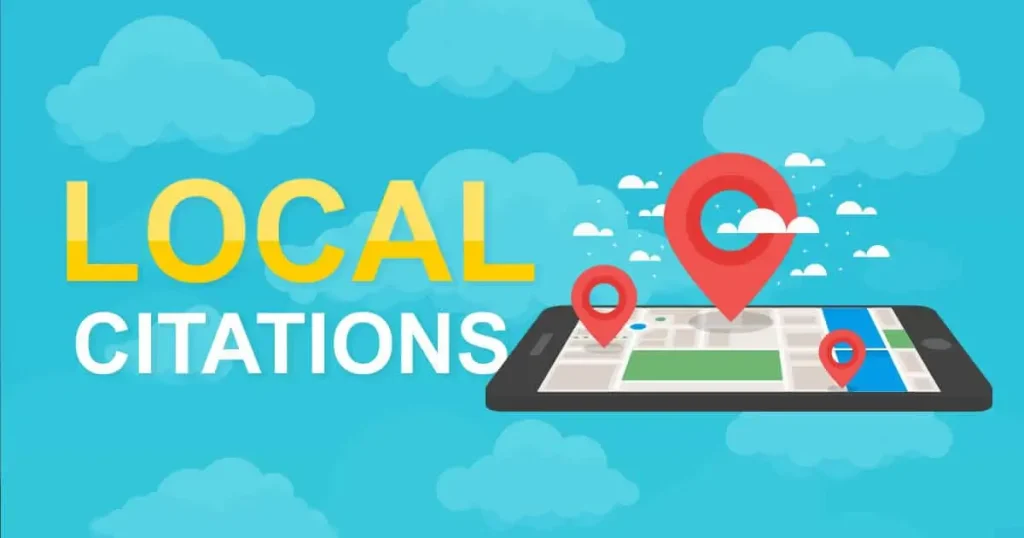Local Citations and Their SEO Impact

Introduction: Local citations play a crucial role in local SEO impact by providing search engines with essential information about a business, such as its name, address, and phone number (NAP). These mentions, found on directories, review sites, and social media platforms, help search engines optimization verify a business’s legitimacy and relevance to local searches. The accuracy and consistency of these citations across various platforms are key factors in improving a website’s visibility in local search results. High-quality citations can boost a business’s local search rankings, increase trust with customers, and drive more local traffic. Moreover, local citations contribute to establishing a business’s authority within its industry and geographic area. For effective local SEO, businesses must focus on obtaining citations from reputable and relevant sources. Overall, local citations are a foundational element in enhancing a business’s online presence and local SEO success. What Are Local Citations? Local citations refer to any online mention of a business’s name, address, and phone number (NAP), typically found on websites, directories, social media platforms, and review sites. These citations help search engines like Google identify and validate the business’s presence in a specific location. They can be structured, like listings in online directories (e.g., Yelp, Yellow Pages), or unstructured, such as mentions in articles or blog posts without direct links to the business website. Accurate and consistent local citations are important for local SEO, as they enhance a business’s visibility in local search results, build trust with customers, and improve overall search engine rankings. How to Build High-Quality Local Citations Creating authoritative local citations is an essential element of successful local SEO. When done correctly, it can significantly improve your local search rankings and help customers find your business more easily. Here’s a step-by-step guide to building high-quality local citations: 1. Maintain Consistent NAP (Name, Address, Phone Number) Across All Platforms: Accuracy is Key: Ensure that your business name, address, and phone number (NAP) are consistent across all listings. Inconsistent or incorrect NAP data can confuse search engines and customers, negatively impacting your rankings. Standardize the Format: For example, always use “Suite” instead of “#”, or write out your address consistently (e.g., “123 Main St” vs. “123 Main Street”). Update Your Website: Ensure your NAP is accurate on your website, particularly in the footer or header, as this will be your reference point when submitting to directories. 2. Take Control of and Enhance Your Google My Business (GMB) Profile Claim and thoroughly enhance your Google My Business profile, as it is a key citation for boosting your local SEO efforts. Add accurate business information, hours of operation, website URL, and high-quality images. Use Categories and Keywords: Select the most relevant business categories, and include a well-crafted description with target local keywords to enhance search visibility. Encourage Reviews: Encourage satisfied customers to leave reviews on your GMB profile, as positive reviews can improve rankings and trust. 3. Submit to High-Quality, Industry-Relevant Directories: Start with Major Directories: Submit your business to prominent local and national business directories such as Yelp, Yellow Pages, and BBB. These directories hold strong authority and can greatly influence your SEO. Industry-Specific Directories: Prioritize directories that are tailored to your particular field. For instance, if you’re in healthcare, submitting to Healthgrades or Zocdoc can increase local visibility. Regional Directories: Search for regional or city-based directories that cater specifically to businesses in your area. These citations help establish your business’s relevance to local searches. 4. Leverage Local Websites and News Outlets: Local News Websites: If your business has been featured in local news or magazines, ask for a citation. Being mentioned in trusted local outlets increases your credibility and authority. Local Blogs and Industry Sites: Reach out to local bloggers, industry influencers, and websites that may be interested in featuring your business. These backlinks can improve SEO and create unstructured citations. 5. Ensure Citations Are On High-Authority Sites: Choose Trustworthy Platforms: When selecting where to submit citations, focus on high-authority sites, as search engines value mentions from credible, well-established platforms. Avoid Spammy Directories: Stay away from low-quality or spammy directories that may have little value or could even hurt your SEO efforts. Google may penalize businesses for citing on dubious sites. 6. Monitor and Update Citations Regularly: Audit Citations for Accuracy: Use tools like Moz Local, BrightLocal, or Yext to audit your business citations. These tools can help identify incorrect or inconsistent NAP data and help you update them. Fix Duplicate Listings: Duplicate citations can hurt your rankings. Ensure your business is listed only once in each directory and remove any duplicates. Update Information: If your business changes its address, phone number, or website, promptly update your citations to reflect these changes. Inconsistent information can negatively impact search rankings. 7. Utilize Social Media and Local Platforms: Social Media Profiles: Make sure your business is active on popular social platforms like Facebook, Instagram, LinkedIn, and Twitter. Include NAP information where possible. Local Review Sites: Participate in local review platforms like TripAdvisor (for hospitality), Angie’s List (for home services), or others relevant to your business type. Respond to reviews to boost engagement and build trust. 8. Build Local Citations Over Time: Pace Your Citation Building: Don’t try to build hundreds of citations in a short period, as this may appear unnatural to search engines. Instead, build citations gradually over time for a more organic SEO impact. Focus on Quality, Not Quantity: A few high-quality, authoritative citations will have a more significant impact than many low-quality ones. 9. Track Your Results: Monitor Citation Impact: Use local SEO tools like Google Analytics and Search Console to track how your citations affect local rankings and web traffic. Adjust Based on Data: Analyze which directories or platforms are driving the most traffic and engagement, then focus on optimizing those sources. Conclusion: Local citations are a cornerstone of local SEO strategy, directly influencing your visibility, credibility, and customer trust. By creating accurate, high-quality citations and avoiding common mistakes, businesses can optimize their online presence and improve local search rankings. Leverage
Optimizing Google My Business Listing

Introduction: Optimizing your Google My Business (GMB) listing is a crucial step for any local business aiming to enhance its online presence. A well-optimized GMB profile not only increases visibility but also improves your chances of attracting potential customers in your area. By providing accurate business information, adding compelling images, and encouraging customer reviews, you can significantly boost your ranking in local search results. Additionally, regularly updating your listing with posts, offers, and new services helps keep your audience engaged. Ensuring consistency across all online platforms further builds trust with Google and customers alike. Effective optimization leads to higher foot traffic and conversions, making it an essential strategy for local SEO. Let’s dive into the best practices for maximizing the impact of your GMB listing. What is Google My Business? Google My Business (GMB) is a no-cost service offered by Google that enables businesses to control their online presence, making it visible in search results and on Google Maps. It enables business owners to create and update their business profile with essential information such as the business name, address, phone number, hours of operation, and more. By claiming and optimizing a GMB listing, businesses can increase their visibility in local search results, engage with customers through reviews, post updates, and provide additional content such as photos and promotions. It’s an essential tool for improving local SEO and helping businesses attract nearby customers. Why Optimizing Your GMB Listing is Crucial Enhancing your Google My Business (GMB) listing is essential for a variety of important reasons. First, it directly impacts your visibility in local search results and Google Maps, making it easier for potential customers to find you when they search for relevant services or products nearby. A well-optimized GMB profile also boosts your credibility, as accurate business details, positive reviews, and frequent updates help establish trust with both Google and consumers. Additionally, optimizing your GMB listing improves your chances of appearing in the coveted “Local Pack” — the top three businesses that appear in local search results. This higher visibility leads to increased foot traffic, more phone calls, and more conversions, ultimately driving business growth. Step-by-Step Guide to Optimize Your GMB Listing Optimizing your Google My Business (GMB) listing is a key strategy to enhance your local SEO and attract more customers. Here’s a step-by-step guide to help you optimize your GMB listing effectively: 1. Claim and Verify Your Business: If you haven’t already claimed your business, visit the Google My Business website and search for your business. If your business isn’t listed, go ahead and add a new entry. Google will send a verification code to your business address (or other methods) to confirm you’re the rightful owner. Follow the instructions to complete the verification. 2. Complete Your Business Information: Business Name: Ensure your business name is consistent with what is used on your website and other platforms. Address: Add a precise location (if you have a physical storefront) or set service areas if you deliver goods or services. Phone Number: Include a local phone number rather than a generic call center number to make it easier for customers to reach you. Website URL: Add a link to your business website to give customers access to more information. 3. Choose the Right Categories: This helps Google understand your business and show it in the right search results. Be specific, but don’t over-categorize.You can also add secondary categories if your business offers a wide range of services. 4. Add High-Quality Photos: Upload a variety of images such as your storefront, interior, staff, products, and services. Photos increase engagement and help customers visualize your business.Consistently refresh your photos to maintain an up-to-date and engaging profile. 5. Write a Compelling Business Description: Craft a concise and informative business description that highlights your unique selling points, services, and mission. Use relevant keywords but avoid keyword stuffing.Limit your description to 750 characters, highlighting the unique qualities that set your business apart. 6. Enable and Manage Reviews: Motivate happy customers to share their positive feedback by leaving reviews on your GMB profile. Respond to both positive and negative reviews in a timely, professional manner to show that you value customer feedback.High ratings and positive reviews contribute to trust and can influence your ranking in local searches. 7. Update Hours of Operation: Make sure your business hours are accurate, including special hours for holidays. Incorrect hours can frustrate customers and hurt your credibility.If your hours change seasonally or during holidays, be sure to update them in advance. 8. Post Regular Updates: Use the “Posts” feature on GMB to share news, promotions, events, or updates. This helps keep your customers updated and actively connected with your business. Posts can be used to highlight offers, new products, or any changes to your services. 9. Utilize GMB Messaging: Activate the messaging feature to give potential customers a direct way to reach out to you via your GMB listing. This feature makes your business more accessible and improves customer interaction. 10. Add Services and Products: List your services or products in detail to help potential customers understand what you offer. Be specific and detailed in your descriptions, and include pricing if applicable. 11. Monitor Insights and Performance: Regularly check the GMB dashboard to track how customers are finding your listing, where they’re coming from, and what actions they’re taking (calls, website visits, requests for directions).Use this data to adjust your strategy, improve your listing, and enhance customer engagement. Conclusion: Optimizing your Google My Business listing is a must for any business seeking to thrive locally. By following these steps, you can improve your visibility, attract more customers, and boost your bottom line. Start today and reap the rewards of a well-optimized GMB profile. Also Read: Local Citations and Their SEO Impact
Effective Link Building Strategies for SEO

Introduction: Effective Link Building Strategies for SEO is an essential aspect of search engine optimization (SEO) that can significantly impact your website’s search rankings and domain authority. By acquiring high-quality backlinks, you not only improve your site’s credibility but also drive organic traffic. But what are the most effective strategies to ensure your link-building efforts yield the desired results? This blog explores the top methods to enhance your SEO game. 1. Create High-Quality Content: Producing top-tier content is vital for grabbing your audience’s attention and earning their trust. It goes beyond just filling pages with words; it involves delivering valuable, well-researched, and engaging material that addresses the needs and interests of your readers. High-quality content can build your brand’s credibility, improve search engine rankings, and foster deeper connections with your audience. Crafting such content requires a combination of creativity, expertise, and strategy. Ultimately, when executed effectively, high-quality content serves as a powerful tool for business growth and online influence. 2. Guest Blogging: Guest blogging is a powerful strategy that involves writing and publishing content on other people’s websites to expand your reach and influence. By contributing valuable insights to established platforms, you can increase your visibility, connect with new audiences, and build backlinks to improve SEO. This collaborative approach benefits both the guest blogger and the host website, fostering mutually advantageous relationships. Guest blogging also allows you to showcase your expertise while diversifying your content portfolio. When done correctly, it can significantly enhance your online presence and credibility. 3. Build Relationships in Your Industry: Building relationships in your industry is a crucial step toward long-term success and growth. By connecting with key players, influencers, and peers, you create a supportive network that can offer insights, opportunities, and collaboration. Strong professional relationships foster trust and open doors to new ventures, partnerships, and business ventures. Engaging in meaningful interactions helps establish your reputation as a valuable member of the industry. Ultimately, nurturing these connections can lead to both personal and professional advancement. 4. Leverage Broken Link Building: Leverage broken link building is a smart SEO strategy that involves identifying broken or dead links on websites and offering your own content as a replacement. By finding these links, you help website owners fix errors while gaining valuable backlinks to your own site. This technique not only boosts your SEO efforts but also builds relationships with other webmasters. Broken link building requires careful research and the ability to create high-quality, relevant content. When done correctly, it enhances both your website’s authority and the overall user experience on the web. 5. Utilize Social Media for Outreach: Utilizing social media for outreach is an effective way to connect with a wider audience and build meaningful relationships. Platforms like Twitter, LinkedIn, and Instagram allow you to engage directly with industry influencers, potential clients, and like-minded professionals. By sharing valuable content, initiating conversations, and responding to inquiries, you can position yourself as a trusted voice in your field. Social media outreach can also drive traffic to your website and increase brand visibility. When used strategically, social media becomes a powerful tool for networking, collaboration, and business growth. 6. List Your Website in Directories: Listing your website in online directories is an effective way to improve its visibility and reach a broader audience. Directories categorize websites by industry, making it easier for potential visitors to discover your content or services. This practice can enhance your SEO by providing valuable backlinks that boost search engine rankings. Additionally, being featured in reputable directories helps build credibility and trust with users. When strategically selected, directory listings can significantly contribute to your website’s online presence and overall success. 7. Create Infographics: Designing infographics is an excellent method to transform complex data into visually appealing and easily digestible content. By combining data, graphics, and concise text, infographics capture attention and make content more memorable. They are particularly useful for breaking down statistics, processes, or comparisons in a way that resonates with audiences. Infographics not only enhance user experience but also encourage social sharing, boosting your content’s reach. When crafted thoughtfully, infographics can become powerful tools for educating and engaging your audience. 8. Offer Testimonials: Offering testimonials is a powerful way to build trust and credibility with potential customers. By sharing positive feedback from satisfied clients or partners, you provide social proof that your products or services deliver value. Testimonials create an authentic connection, as they showcase real experiences and results. This practice helps establish your reputation as a reliable and trustworthy brand. When used strategically, testimonials can significantly influence purchasing decisions and enhance customer loyalty. 9. Conduct Outreach Campaigns: Conducting outreach campaigns is a proactive strategy for building connections and expanding your brand’s influence. These campaigns involve reaching out to influencers, bloggers, or potential partners to foster relationships and collaborate on mutually beneficial projects. By targeting the right audience with personalized messages, you can increase your visibility and credibility in your industry. Outreach campaigns also help in gaining backlinks, boosting your SEO efforts, and driving traffic to your website. When executed thoughtfully, outreach campaigns can open doors to valuable opportunities and growth. 10. Monitor Your Backlinks: Monitoring your backlinks is a crucial aspect of maintaining a strong online presence and improving SEO performance. By regularly checking the quality and relevance of your backlinks, you ensure that they contribute positively to your website’s authority. This practice helps identify and disavow harmful or broken links that may negatively impact your rankings. Tracking backlinks also provides insights into your competitors’ strategies and allows you to capitalize on new opportunities. Consistent backlink monitoring ultimately supports sustainable growth and enhances your website’s search engine visibility. Conclusion: Effective link-building is a long-term strategy that requires patience and consistency. By focusing on quality over quantity and employing the techniques outlined above, you can boost your website’s SEO performance and achieve lasting success. Start today, and watch your site climb the search rankings! Also Read: Optimizing Google My Business Listing
Guest Blogging for Link Building

Introduction: In the world of digital marketing, building high-quality backlinks is one of the most important strategies for improving search engine rankings. Backlinks act as “votes of confidence” from other websites, signaling to search engines like Google that your content is trustworthy, valuable, and worth ranking higher. One of the most effective ways to acquire these backlinks is through guest blogging. But what exactly is guest blogging, and how can it help with link building? What is Guest Blogging? Guest blogging involves writing and publishing an article or blog post on someone else’s website or blog. In exchange for contributing valuable content, the guest blogger typically receives a backlink to their own site. This type of content collaboration not only exposes the guest blogger to a new audience but also helps them build their online presence and authority. Key Benefits of Guest Blogging for Link Building: Improves Domain Authority: High-quality backlinks from reputable sites boost your website’s domain authority (DA). Increases Website Traffic: Guest blogging introduces your content to new audiences, leading to higher referral traffic. Builds Brand Credibility: Being featured on authoritative sites positions you as an industry expert.Establishes Relationships: Collaborating with niche blogs fosters strong industry connections. Steps to Successful Guest Blogging for Link Building Guest blogging is one of the most effective ways to build high-quality backlinks to your website while also enhancing your visibility and authority in your industry. However, to truly succeed with guest blogging for link building, it’s important to follow a strategic process. Here’s a step-by-step guide to ensure your guest blogging efforts lead to strong SEO results and long-term success. 1. Identify the Right Websites for Guest Posting: The first step in any guest blogging campaign is selecting the right websites to contribute to. Not all blogs or websites are suitable for building backlinks. You want to focus on websites that: Are Relevant to Your Niche: The website should be in the same industry or a related niche. A relevant blog will help ensure your guest post reaches the right audience, and the backlink will be seen as valuable by search engines. Have High Domain Authority: Look for websites that have good domain authority (DA). Websites with a higher DA are more trusted by search engines and can pass more value to your website through backlinks. Are Active and Have Engaged Audiences: A site that regularly posts content and has an engaged audience (e.g., through social media shares, comments, or discussions) will help drive more traffic to your guest post and increase the likelihood that readers will follow your link. 2. Research and Understand the Host Website’s Audience: Once you’ve identified potential guest blogging opportunities, take the time to research and understand the audience of each website. Look for: Content Style and Tone: Analyze the type of content that resonates with the audience. Is the tone formal or conversational? Is the content more educational or opinion-based? Make sure your writing aligns with the host site’s style. Popular Topics: Browse through past guest posts and other content on the site to identify common themes and topics. Find out what the audience engages with the most to increase the chances of your post being accepted. Engagement Patterns: Look for how readers engage with the content—are there lots of comments or social media shares? This will help you understand what type of content is likely to gain traction and generate traffic. 3. Craft a High-Quality, Relevant Guest Post: The core of a successful guest blog post lies in the quality of the content. Your post should: Provide Value: Offer something that benefits the host website’s audience. This could be new insights, actionable tips, or solutions to common problems in your industry. When you provide high-value content, readers are more likely to trust your expertise and follow your backlinks. Be Well-Written: Ensure your post is well-researched, grammatically sound, and easy to read. High-quality writing is key to establishing your authority and building a good relationship with the host website. Stay On-Topic: Make sure the topic of your post is directly relevant to the website’s focus. Guest posts that feel out of place or unrelated to the website’s theme will not be accepted and can hurt your credibility. Include Natural Backlinks: When adding backlinks to your website, ensure they are placed naturally within the content. Avoid excessive or unnatural keyword-rich anchor text. Instead, use a variety of anchor text and integrate the link in a way that flows well with the content. 4. Submit Your Guest Post and Follow Guidelines: Every website has its own guest post submission guidelines, and following these is crucial for success. Guidelines may include: Post Length: Some sites may have a word count requirement, while others may prefer a specific structure. Adhering to the guidelines demonstrates professionalism and respect for the host site’s editorial standards. Image and SEO Guidelines: Some sites may ask for images or specific SEO optimizations (such as including keywords, meta descriptions, etc.). Make sure you meet these requirements. 5. Promote Your Guest Post: After your guest post goes live, don’t simply relax and expect the traffic to roll in on its own. You should actively promote it to maximize the benefits: Share on Social Media: Share the link to your guest post on all of your social media platforms. Tag the host site and any people mentioned in the post to increase visibility and engagement. Encourage Interaction: If the website allows comments, be sure to respond to any comments or questions from readers. This helps to build a relationship with the host site’s audience and shows you care about the conversation. Conclusion: Guest blogging remains one of the most effective strategies for link building when done properly. By contributing high-quality content to authoritative websites within your niche, you can acquire valuable backlinks that boost your SEO efforts, expand your reach, and establish your authority in your industry. However, it’s important to remember that guest blogging should always be about creating value, building relationships, and providing informative content
Creating an SEO-Friendly Site Architecture

Introduction: Creating an SEO-friendly site architecture is essential for improving a website’s visibility and usability. It involves organizing the site in a way that both search engines and users can easily navigate. A well-structured website helps search engines crawl and index pages efficiently, boosting rankings. Key elements include clear hierarchy, optimized URL structures, and strategic internal linking. Mobile optimization and fast loading speeds are crucial for maintaining user engagement. Sitemaps and breadcrumbs further enhance navigation and SEO performance. Ultimately, an SEO-friendly site architecture ensures a seamless experience for both users and search engines, leading to better traffic and higher rankings. What Is Site Architecture? Site architecture refers to the structural design and organization of a website’s pages and content. It involves planning how the website is laid out, how different pages are linked together, and how users and search engines navigate through the site. The goal of site architecture is to create a logical and intuitive structure that allows both visitors and search engine crawlers to easily find, access, and understand the content on the site. Good site architecture includes the following elements: Hierarchy: The arrangement of pages in a logical, tiered structure, with the homepage at the top, followed by category pages, subcategories, and individual content pages. URL Structure: The way URLs are formatted to be clean, descriptive, and user-friendly, with appropriate use of keywords. Navigation: Menus, links, and other navigational elements that guide users through the site and help them find information quickly. Internal Linking: The strategy of linking related pages within the site to improve navigation and help search engines understand the relationships between pages. Usability and Mobile-Friendliness: A site that is easy to use and navigate on all devices, from desktops to smartphones, is a critical component of good site architecture. Why Is SEO-Friendly Site Architecture Important? SEO-friendly site architecture is essential for improving both search engine rankings and user experience. A well-structured site helps search engines crawl and index content efficiently, leading to better visibility. It also ensures easy navigation for users, reducing bounce rates and increasing engagement. Proper internal linking and optimized URL structures enhance the distribution of page authority across the site. Ultimately, a strong site architecture supports higher rankings, more traffic, and a seamless user experience. Here are some key reasons why it’s important: Improved Crawlability and Indexing: Search engines like Google rely on site architecture to crawl and index a website’s pages. A clear, organized structure helps search engines discover all your content and understand how pages are related, which can lead to better rankings. Better User Experience: A well-structured website is easier for users to navigate, helping them find information quickly. This improves user satisfaction, engagement, and increases the likelihood of conversions or return visits. Increased Page Authority Distribution: Internal linking within an SEO-friendly architecture helps distribute link authority across the site, improving the SEO potential of individual pages. Faster Page Load Times: Proper site architecture, including optimized media and minimal page complexity, can lead to faster loading times. Mobile Optimization: With the rise in mobile traffic, an SEO-friendly site architecture ensures the website is responsive, providing a seamless experience across devices, which is essential for rankings in mobile-first indexing. Reduced Bounce Rate: An easy-to-navigate structure keeps visitors on the site longer, reducing the bounce rate and increasing the chance of users exploring more pages. Enhanced Search Engine Rankings: A site that is both user-friendly and optimized for search engines will likely see higher rankings, more organic traffic, and improved visibility across search results. How to Create an SEO-Friendly Site Architecture Creating an SEO-friendly site architecture is essential for improving your website’s search engine rankings and user experience. It ensures that search engines can easily crawl and index your content while providing a seamless and intuitive experience for visitors. Here are key steps to help you create a site structure that benefits both SEO and users: Plan a Logical Hierarchy: Start by organizing your site into a clear and logical hierarchy. Organize your site by positioning key pages, such as the homepage, at the highest level, followed by category sections, subcategories, and specific content pages. This structure mirrors how users seek information and helps search engines understand the relationships between your pages. Use SEO-Friendly URLs: URLs should be clear, concise, and easily understandable. Include relevant keywords where possible, but avoid using lengthy or complicated URL strings. For example, instead of “yourwebsite.com/page?id=123,” use “yourwebsite.com/seo-tips.” This not only makes URLs more user-friendly but also signals to search engines what the page is about. Ensure Clear Navigation: A user-friendly navigation system is crucial. Menus should be easy to follow, allowing users to quickly find relevant content. Main category menus, submenus, and footer links should all guide users through the site’s structure. Make sure important pages are easily accessible from any section of the site. Optimize Internal Linking: Internal linking helps both users and search engines navigate your site more efficiently. Connect related pages within your content to assist search engines in finding additional pages and enhancing the flow of page authority. This also motivates users to navigate further within your site. Make Your Site Mobile-Friendly: With mobile-first indexing becoming the standard for search engines, ensuring your site is mobile-responsive is crucial for SEO. A mobile-friendly design improves user experience and ensures your site ranks well across all devices. Conclusion: Creating an SEO-friendly site architecture is fundamental for online success. By implementing a clear hierarchy, optimizing internal linking, and leveraging tools like breadcrumbs and sitemaps, you can enhance user experience and improve search engine rankings. Regular audits and continuous optimization are key to staying ahead in the competitive digital landscape. Also Read: Guest Blogging for Link Building
Technical SEO: A Beginner’s Guide

Introduction: “Technical SEO: A Beginner’s Guide” introduces the foundational concepts of optimizing a website’s technical elements to improve its visibility on search engines. Unlike content-based SEO, which focuses on keywords and backlinks, technical SEO targets the backend factors that influence how search engines crawl, index, and rank a site. Key areas include website structure, site speed, mobile responsiveness, and ensuring secure connections (HTTPS). This guide aims to break down these complex topics for beginners, providing practical insights to enhance website performance. beginner’s technical SEO is essential for creating a solid foundation for higher rankings and better user experiences. By optimizing these technical aspects, websites can improve both their search engine visibility and user engagement. Whether you’re building a new website or optimizing an existing one, this guide offers crucial steps to make your site more search-engine-friendly. What is Technical SEO? The Beginner’s guide of Technical SEO refers to the process of optimizing a website’s technical aspects to improve its search engine rankings and overall user experience. Unlike content-focused SEO, which revolves around keywords and backlinks, technical SEO focuses on improving the underlying structure of a website so that search engines can crawl, index, and render it effectively. Key components of technical SEO include: Website Structure: Ensuring your website is organized in a way that is easy for search engines to crawl and understand, including clear navigation and a logical URL structure. Site Speed: Optimizing page load times to enhance both user experience and search engine rankings. Mobile-Friendliness: Making sure the website is responsive and provides a seamless experience on mobile devices. Secure Connections (HTTPS): Using secure protocols to encrypt data and boost trustworthiness in search engine results. XML Sitemaps: Helping search engines understand the structure of your site and discover new content easily. Fixing Crawl Errors: Identifying and resolving issues that may prevent search engines from accessing your site properly. Why is Technical SEO Important? Technical SEO is important because it forms the foundation of a website’s ability to be discovered and ranked by search engines. Even if a website has high-quality content, poor technical SEO can hinder its performance in search engine results. Here’s why technical SEO is crucial: Improve Crawling and Indexing: Search engines need to access and understand your content. Enhance User Experience: Optimized speed and structure improve usability. Boost Rankings: Search engines prioritize well-structured and optimized sites. Key Elements of Technical SEO Key Elements of Technical SEO are the foundational factors that help optimize a website’s backend structure, enabling search engines to crawl, index, and rank it effectively. These elements are critical for ensuring that a website not only performs well technically but also provides a positive user experience. By addressing these technical elements, you can improve your site’s visibility, search engine rankings, and overall performance. Understanding and optimizing these key elements is essential for any website aiming to succeed in search engine results pages (SERPs). Website Structure: An organized and intuitive website structure is crucial for ensuring a smooth experience for both visitors and search engines. Mobile Optimization: Make sure your website is optimized for mobile devices, as Google prioritizes mobile-first indexing. Tools like Google’s Mobile-Friendly Test can help. Page Speed Optimization: Fast-loading pages are critical for user satisfaction and rankings. HTTPS Protocol: Secure websites (using HTTPS) are trusted more by search engines. Canonicalization: Prevent duplicate content issues with proper canonical tags. Schema Markup: Use structured data to boost your presence in search results by enabling rich snippets. Crawlability and Indexing: How to Perform a Technical SEO Audit How to Perform a Technical SEO Audit is a comprehensive process of evaluating a website’s technical aspects to identify areas for improvement in search engine optimization. A technical SEO audit helps uncover issues that may be hindering a website’s visibility, crawling, or ranking on search engines. The audit typically includes checking for broken links, analyzing site speed, reviewing mobile responsiveness, ensuring proper indexing, and validating the structure of URLs, sitemaps, and metadata. By systematically assessing these technical factors, webmasters can pinpoint issues that may be affecting performance and prioritize solutions that will enhance the website’s search engine presence. Performing a technical SEO audit is essential for maintaining optimal website health and ensuring long-term SEO success. Crawl Your Website: Use tools like Screaming Frog or SEMrush to identify issues. Check Mobile Usability: Ensure all pages are responsive and work seamlessly on mobile devices. Analyze Page Speed: Tools like Google PageSpeed Insights help diagnose performance issues. Review Robots.txt and XML Sitemap: Ensure proper guidelines for search engines. Fix Broken Links: Audit for 404 errors and resolve them promptly. Ensure Secure Protocol: Upgrade to HTTPS if not already implemented. Technical SEO Best Practices Conclusion: Technical SEO is the cornerstone of any successful SEO strategy. By understanding and implementing the basics covered in this guide, you can significantly improve your website’s visibility, performance, and user experience. Regular audits and updates will ensure your site stays optimized for both users and search engines. Also Read: Creating an SEO-Friendly Site Architecture
Mobile Optimization and SEO Best Practices

Introduction: In the current digital era, mobile devices represent a large share of overall internet traffic. As smartphones and tablets continue to dominate the way we browse the internet, ensuring your website is mobile-friendly has become a crucial aspect of Search Engine Optimization. Mobile optimization refers to the process of designing and developing your website to provide the best possible user experience across a wide range of mobile devices. This blog post explores the importance of mobile optimization, its impact on SEO, and the best practices you should follow to ensure your website ranks well and performs optimally on mobile devices. Why Mobile Optimization Matters for SEO Google has shifted its approach to ranking websites in recent years with the advent of mobile-first indexing. This means that Google predominantly uses the mobile version of a website’s content for indexing and ranking, rather than the desktop version. Therefore, a mobile-optimized site is no longer a luxury; it’s a necessity if you want to ensure your website performs well in search results. Moreover, mobile optimization can have direct and indirect effects on SEO: Better User Experience (UX): A mobile-friendly website enhances the overall user experience, which can reduce bounce rates and increase the time users spend on your site. Both of these factors are important signals to Google about the quality of your site. Faster Load Times: Mobile-optimized sites tend to have faster load times, which directly affect user experience and SEO. Google has made it clear that page speed is a ranking factor, and slow loading times can harm your rankings. Higher Conversion Rates: With a seamless mobile experience, users are more likely to complete desired actions, such as making a purchase, filling out a contact form, or subscribing to a newsletter. This can improve your conversion rates, leading to greater business success. Best Practices for Mobile Optimization and SEO To ensure your website is optimized for mobile devices and follows SEO best practices, you should implement the following strategies: 1. Responsive Web Design: One of the most important steps in mobile optimization is implementing a responsive web design. A responsive website automatically adjusts its layout and content to fit different screen sizes, providing a consistent user experience across devices. Instead of creating a separate mobile version of your site (which can be cumbersome and confusing for search engines), responsive design allows you to maintain one site for all users. Benefits of responsive design include: Improved SEO: Google recommends responsive web design because it consolidates mobile and desktop versions of your site under one URL, making it easier for Google to index and rank. Faster Loading Speed: Responsive designs tend to be faster since the page adjusts to the device’s screen size without having to load unnecessary elements. Lower Bounce Rates: When users can easily navigate your site on mobile devices, they’re less likely to leave quickly, resulting in a lower bounce rate. 2. Optimize Page Speed for Mobile: On mobile devices, slow-loading pages can be especially frustrating and may lead users to abandon your site before it fully loads. Google’s mobile-first indexing puts more emphasis on the mobile version of your site’s speed, so optimizing load times for mobile is essential. To optimize page speed, consider the following: Compress Images: Large images can significantly slow down your site. Use Browser Caching: By caching elements of your website, browsers can store data so they don’t need to be reloaded each time the user visits, leading to faster load times. Minify Code: Minifying HTML, CSS, and JavaScript code reduces file sizes and speeds up load times by removing unnecessary spaces and characters. Use Accelerated Mobile Pages (AMP): AMP is an open-source framework designed to make mobile pages load faster. Implementing AMP can improve the performance of your site, especially for content-heavy pages. 3. Prioritize Mobile-Friendly Navigation: On mobile devices, navigation plays a significant role in user experience. A confusing or cumbersome navigation menu can frustrate users, causing them to leave your site. Best practices for mobile navigation include: Simplified Menus: Limit the number of options in the navigation menu to prevent it from being cluttered. Consider using drop-down or hamburger menus to save space. Sticky Navigation Bars: A sticky navigation bar keeps essential links visible as users scroll down the page, making it easy to move around the site. Larger Clickable Areas: Ensure buttons and links are large enough for users to tap easily without accidentally clicking on the wrong element. 4. Ensure Content is Mobile-Optimized: Content plays a significant role in SEO, but on mobile devices, it’s important to ensure that your content is easy to read and navigate. This means considering both text and multimedia elements. To optimize content for mobile: Shorter Paragraphs: Long paragraphs can be overwhelming on smaller screens. Break content into shorter paragraphs and use subheadings to improve readability. Optimized Media: Ensure videos, images, and other media elements are mobile-optimized. Use responsive media that automatically adjusts its size based on screen dimensions. 5. Test Your Site’s Mobile Usability: To ensure your website is mobile-friendly, it’s important to regularly test its mobile usability. Google offers a free Mobile-Friendly Test tool that allows you to check how well your site performs on mobile devices. This tool provides insights into any issues that could impact user experience or SEO and offers suggestions for improvement. In addition to Google’s tools, test your website manually on various mobile devices to identify any areas that need improvement. Conclusion Mobile optimization is no longer optional—it’s an essential aspect of SEO. By ensuring your website provides a smooth, fast, and responsive experience for mobile users, you can improve your search rankings, boost user engagement, and increase conversions. Follow the best practices outlined in this post, including responsive design, page speed optimization, mobile-friendly navigation, and local SEO strategies, to ensure your website performs at its best on mobile devices. With mobile-first indexing becoming the standard, now is the perfect time to optimize your site for mobile. Also Read: Technical SEO: A Beginner’s Guide
Fixing Crawl Errors for SEO

Introduction: Fixing Crawl errors can hinder your website’s SEO performance by blocking search engines from indexing your pages. If left unresolved, these errors can affect your website’s visibility and organic traffic. In this guide, we’ll cover everything you need to know about crawl errors, their types, and how to fix them to boost your SEO. What Are Crawl Errors? Crawl errors occur when search engine bots encounter problems while crawling your website. These issues stop bots from reaching and indexing your pages, which can lead to a decline in your site’s search engine rankings. 1. Site Errors: Site errors affect your entire website, preventing bots from accessing it altogether. Common site errors include: DNS Errors: Occur when bots cannot communicate with your server. Server Errors (5xx): Indicate that your server failed to fulfill the bot’s request. Robots.txt Fetch Issues: Happen when bots are blocked by an incorrectly configured robots.txt file. 2. URL Errors: URL errors occur on specific pages and can result from: 404 Not Found Errors: The requested page doesn’t exist. Access Denied Errors: Bots are restricted from accessing certain pages. Redirect Errors: Misconfigured or endless redirections. Why Fixing Crawl Errors Matters for SEO Fixing crawl errors is a crucial aspect of search engine optimization (SEO) because it directly impacts how well search engines can index and rank your website. If search engines encounter issues while crawling your site, they might not be able to access all of your pages, or they could index outdated or incorrect versions of your content. This can lead to a drop in visibility and rankings, which in turn affects traffic and conversions. Here’s why fixing crawl errors matters for SEO: Crawl errors disrupt this process, leading to: Reduced Search Visibility: Pages with errors won’t appear in search results. Poor User Experience: Broken links and missing pages frustrate visitors. Lower Domain Authority: Search engines may view your site as unreliable. How to Identify Crawl Errors Identifying crawl errors is an essential part of maintaining a healthy website, ensuring that search engines can effectively index your pages. Crawl errors occur when search engine bots (like Google’s crawler) are unable to access or fully index specific pages on your website. These errors can negatively impact your site’s visibility and search rankings. To identify crawl errors, use tools such as: Google Search Console: Navigate to the “Indexing” or “Crawl Errors” section. Screaming Frog SEO Spider: A desktop tool that scans your website for errors. Ahrefs and SEMrush: Provide detailed crawl error reports. Steps to Fix Crawl Errors 1. Fixing Site Errors: DNS Errors: Contact your hosting provider to resolve DNS issues. Server Errors (5xx): Upgrade your hosting plan, or troubleshoot server logs. Robots.txt Fetch Issues: Correct syntax errors in your robots.txt file. 2. Fixing URL Errors: 404 Errors: Implement 301 redirects to relevant pages or update internal links. Access Denied: Adjust your page permissions in your CMS. Redirect Errors: Ensure redirection rules are properly configured. 3. Optimize Crawl Budget: Use Google Search Console’s “URL Parameters” tool to avoid unnecessary crawling.Remove duplicate content to focus bot activity on important pages. Proactive Measures to Prevent Crawl Errors: Regular Audits: Perform routine site audits to catch errors early. Submit Updated Sitemaps: Ensure that search engines have your latest URLs. Optimize Site Speed: Fast-loading sites experience fewer server errors. Monitor Changes: Use alerts from Google Search Console to stay updated on new errors. Conclusion: Fixing crawl errors is essential for maintaining a healthy website and improving your SEO. By addressing site and URL errors, optimizing your crawl budget, and regularly auditing your site, you can ensure search engines access and index your content effectively. Implement these strategies today to enhance your website’s visibility and performance. Also Read: Mobile Optimization and SEO Best Practices
Writing SEO-Optimized Title Tags

Introduction: Writing SEO-optimized title tags is a key element of on-page SEO, as they directly impact both search engine rankings and click-through rates. A well-crafted title tag should include relevant keywords while remaining concise and compelling, ideally under 60 characters. It’s important to create titles that accurately reflect the content, aligning with user search intent. Avoid keyword stuffing and ensure the title is unique for each page. Regularly reviewing and updating title tags can help improve visibility and drive more organic traffic to your website. Why Are Title Tags Important? Title tags are a fundamental element of Search Engine Optimization, as they directly influence how search engines and users perceive your content. They help search engines understand the relevance of your page, affecting its ranking in search results. A well-crafted title tag can also boost click-through rates by capturing user interest and providing clear, concise information about the page. Overall, optimizing title tags is essential for driving traffic and improving user engagement with your site. Title tags are crucial for several reasons: Search Engine Rankings: Title tags are a key on-page SEO factor, as search engines like Google use them to understand the content of your page. Including relevant keywords can help improve your page’s visibility in search results. Click-Through Rates (CTR): A compelling, well-crafted title tag can encourage users to click on your link when it appears in search results, boosting your site’s CTR and organic traffic. User Experience: A clear and descriptive title helps users immediately understand what the page is about, making it more likely they’ll engage with your content. Branding and Credibility: A professional and consistent title tag reinforces your brand identity and can make your website stand out in a crowded search landscape. Social Sharing and Bookmarks: Title tags often appear when your content is shared on social media or bookmarked, contributing to better visibility and user engagement across platforms. Best Practices for Writing SEO-Optimized Title Tags Title tags are among the most important components of on-page SEO. They not only help search engines understand the content of your page but also influence whether users will click through to your site from search results. Writing SEO-optimized title tags requires a strategic balance between clarity, relevance, and optimization. Here are some best practices to ensure your title tags are working hard for your site. 1. Prioritize Your Main Keyword: The first rule of writing effective title tags is to include your primary keyword. This helps search engines quickly understand what your page is about, improving your chances of ranking for that term. Ideally, position the main keyword towards the start of the title, but avoid overloading it—ensure the title flows naturally and remains easy to read. 2. Keep It Concise: Search engines usually show only the first 50-60 characters of a title tag in search results. If your title is too long, it may get cut off, potentially losing important information. Aim to keep your title under 60 characters to ensure that it’s fully visible to users. 3. Make It Descriptive and Compelling: Your title should clearly convey the topic of the page while enticing users to click. A descriptive title that matches the search intent of your target audience will not only improve SEO but also increase your click-through rate (CTR). Use action words or a call to action if relevant (e.g., “Learn how to…,” “Discover…”). 4. Include Your Brand Name: If your brand is well-known, make sure to add it to the title tag, usually towards the end. This not only reinforces your brand’s identity but can also help improve trust and credibility. 5. Avoid Keyword Stuffing: While it’s important to include your main keyword, don’t stuff your title with irrelevant or excessive keywords. A cluttered title tag can confuse both users and search engines, negatively affecting your rankings and CTR. How to Optimize Title Tags for CTR Even if your title ranks well, it needs to attract clicks. Here’s how to maximize CTR: Use Numbers: “Top 10” or “5 Easy Steps” titles perform well. Include a Call to Action: Phrases like “Learn More” or “Try Today” can encourage users to click. Add a Year: Titles with current years signal up-to-date content. Example: SEO Strategies for 2024. Common Mistakes to Avoid Using the Same Title for Multiple Pages: Causes keyword cannibalization. Missing Keywords: Reduces relevance to search queries. Clickbait Titles: May increase bounce rates if the content doesn’t deliver. Conclusion: Crafting effective SEO-optimized title tags is essential for improving your website’s search performance and click-through rates. By following the strategies outlined in this guide, you can create compelling, keyword-rich titles that attract both search engines and users. Regularly revisiting and optimizing your title tags ensures your content stays competitive in the ever-changing digital landscape. Also Read: Fixing Crawl Errors for SEO
Crafting Compelling Meta Descriptions for SEO

Introduction: In the world of Crafting Compelling SEO, meta descriptions are often overlooked, but they play a crucial role in increasing click-through rates (CTR) and improving search engine rankings. A compelling meta description provides a snapshot of your content, enticing users to click through to your site. In this guide, we’ll explore the art of crafting meta descriptions, discuss their significance in SEO, and share actionable tips to create descriptions that work. What Are Meta Descriptions? A Crafting Compelling Meta Descriptions for SEO is a brief text snippet embedded in a webpage’s HTML, created to summarize the page’s content for both search engines and visitors. While meta descriptions are not a direct ranking factor for search engines like Google, they play a significant role in influencing click-through rates (CTR) by providing searchers with a quick preview of the content. Key Features of a Meta Description: Length: Typically between 150-160 characters (though this can vary slightly depending on the search engine or device). Content: Should be concise, clear, and relevant to the page’s content. Purpose: To encourage users to click on the search result by making the content seem useful, interesting, and relevant to their query. No Direct Ranking Impact: While meta descriptions themselves do not directly affect rankings, a compelling meta description can lead to more clicks, which in turn can positively influence rankings indirectly. Best Practices for Writing Meta Descriptions: Be Descriptive: Summarize the page’s content accurately to match the user’s query. Use Keywords: Include target keywords where appropriate, but avoid keyword stuffing. Make It Actionable: Use calls to action (e.g., “Learn more”, “Get started”, “Discover tips”) to encourage clicks. Unique for Each Page: Ensure every page on your site has a unique meta description.Match User Intent: Tailor the description to the type of content and what the user is likely searching for. Why Are Meta Descriptions Important? Meta descriptions are a crucial element of on-page SEO and play a significant role in driving traffic to your website. Key Elements of a Good Meta Description 1. Length Matters: 2. Use Keywords Wisely: 3. Incorporate a Call-to-Action (CTA): 4. Make It Unique: 5. Provide Value: Crafting Perfect Meta Descriptions: Step-by-Step Guide Step 1: Understand Your Audience: Know your target audience’s search intent and preferences. This ensures your meta description resonates with their needs. Step 2: Analyze Competitors: Examine competitor meta descriptions for inspiration but focus on making yours stand out. Step 3: Highlight Benefits: Emphasize what sets your content apart, whether it’s a detailed guide, exclusive offers, or actionable tips. Step 4: Include Keywords: Integrate keywords naturally to align with user queries. Step 5: Add a CTA: Motivate users to take the desired action with an effective CTA. Common Mistakes to Avoid Keyword Stuffing: Overusing keywords can make the description sound unnatural. Too Generic: Avoid vague descriptions that don’t provide specific value. Overlooking Mobile Users: Ensure your description is mobile-friendly, as most searches now happen on mobile devices. Conclusion: By focusing on clarity, relevance, and engagement, you can create meta descriptions that not only improve your CTR but also enhance your site’s overall SEO performance. Implement these tips to optimize your meta descriptions and watch your organic traffic grow! Also Read: Writing SEO-Optimized Title Tags
